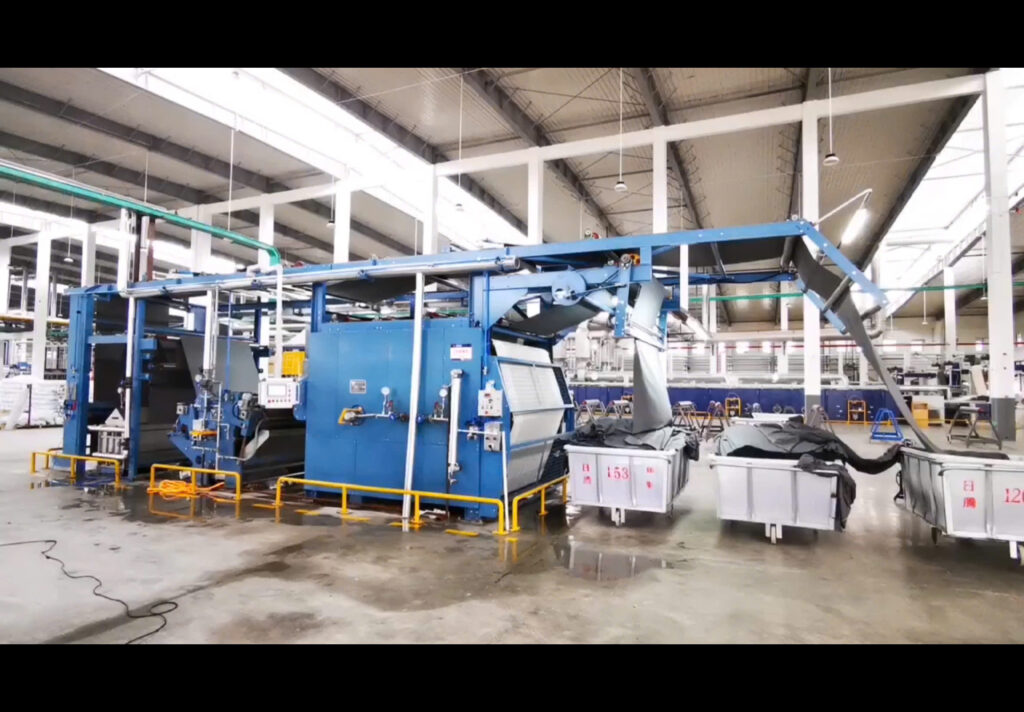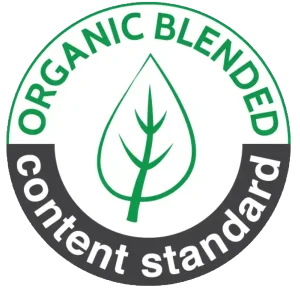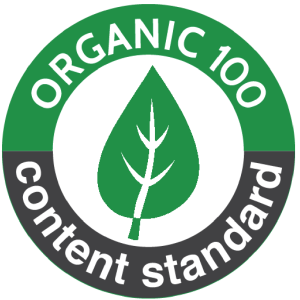Fabric finishing is a crucial step in the textile finishing process, aimed at improving the quality, durability, and aesthetics of products. Depending on technical requirements and intended use, factories will select specialized equipment to manipulate the surface structure, from smoothing and dimension-setting to creating aesthetic effects.
Below are the typical types of machinery commonly used in the fabric finishing stage today.
1. Sanforizing Machines for Fabric Surface Finishing – Stabilizing Dimensions and Limiting Shrinkage
Nội dung tóm tắt
ToggleA sanforizing machine is a specialized device used to set the dimensions and stabilize the size of the fabric. After dyeing or enzyme washing, fabric often tends to shrink. Processing it through a sanforizing machine helps control the shrinkage, ensuring the finished product maintains a stable size after washing.
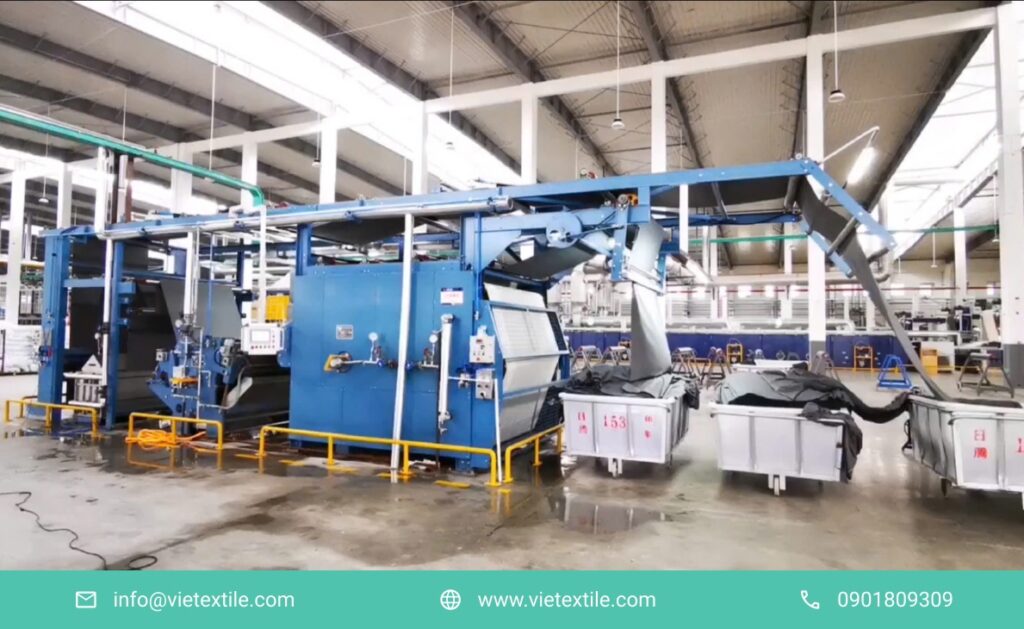
Main Role of the Sanforizing Machine: The sanforizing machine’s task is to compress the fibers and control shrinkage along the width, which helps stabilize dimensions after the fabric has been dyed or enzyme-treated. This is a core step in the process to prevent product deformation.
Key Advantages: It increases the dimensional stability of the fabric, limiting the shrinkage phenomenon after washing. This equipment is particularly effective for materials like cotton, denim, or knit fabrics – which tend to shrink significantly.
Practical Applications: Sanforizing machines are widely used in the high-end apparel industry, for producing uniforms, jeans, and any product that requires high dimensional stability of the fabric during use.
➡️ For workshops that focus on finished product quality, fabric surface finishing with a sanforizing machine is an essential step.
2. Brushing Machines for Fabric Surface Finishing – Creating Smoothness and Enhancing Aesthetics

A brushing machine is a specialized device used to create a slightly fluffy, smooth, or plush surface on the fabric. This process enhances aesthetics, creates a soft feel, and provides better warmth.
Operating Mechanism in Fabric Surface Finishing: A brushing machine operates based on a system of rollers covered with carding wires or high-speed rotating brushes to “brush” the fabric fibers outward, creating a controlled fluffy surface effect. This is a key stage in the fabric surface finishing process to increase aesthetic value and softness.
Key Advantages: The brushing process helps create fabrics like fleece and flannel with a smooth, soft, and warm surface. Brushing also enhances a pleasant handfeel, thereby increasing the use value of the product after finishing.
➡️ Surface modification of fabric with a brushing machine not only creates an attractive effect but also meets seasonal usage demands.
3. Sueding Machines for Fabric Surface Finishing – Creating a Velvety, Smooth Effect
This is a device that uses sandpaper or abrasive rollers to smooth the fabric surface, giving it a velvety or suede-like feel.
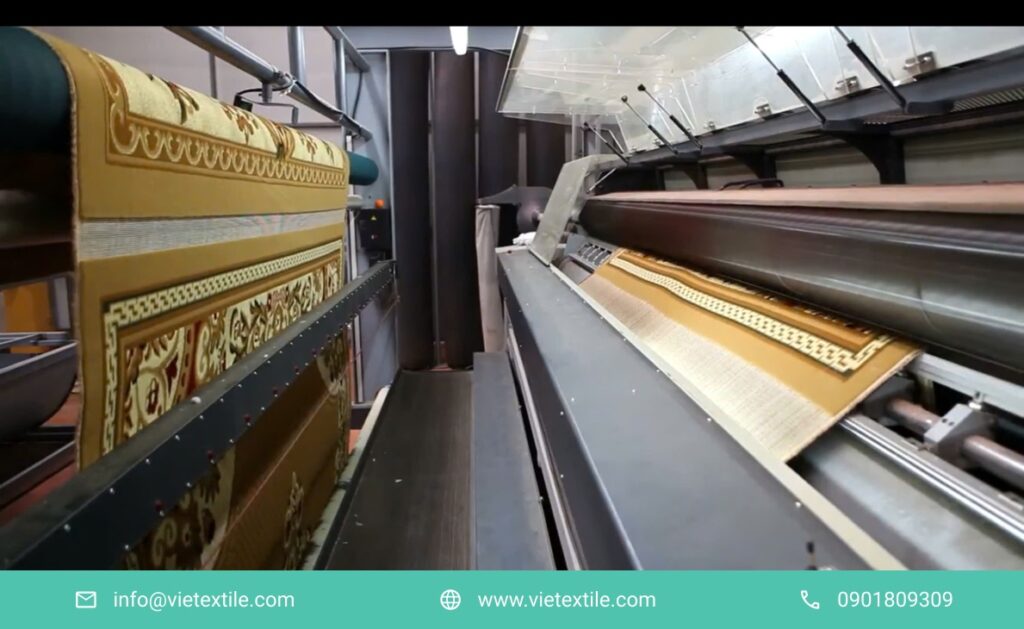
Key Advantages of a Sueding Machine: The sueding machine helps create a soft, smooth surface and effectively limits pilling. When integrated into the fabric surface finishing process, this equipment helps improve handfeel and increases the sophistication of the finished product.
Material Compatibility: Sueding machines are highly suitable for processing plain woven fabrics, polyester blends, or microfiber. Especially when applying fabric surface finishing to these materials, the smoothing effect is optimized without damaging the fiber structure.
Practical Applications: After processing, the fabric achieves a beautiful smoothness, suitable for use in upholstery, high-end fashion, or products that require a soft and luxurious surface. This is a crucial stage in the fabric surface finishing chain at many modern factories.
➡️ In the fabric finishing process, a sueding machine is an ideal choice for creating a refined texture.
4. Calendering Machines for Fabric Surface Finishing – Increasing Gloss and Flatness
A calendering machine is a device that uses high heat and pressure to make the fabric surface more glossy and smooth. This equipment is especially important in finishing lines for polyester or satin fabrics.
Operating Principle in Fabric Surface Finishing: A calendering machine uses a heated steel roller with high pressure to press the fabric surface. The combination of heat and pressure helps flatten the fabric fibers, creating a smooth and uniform glossy effect – a critical step in the fabric surface finishing stage.
Key Advantages: This equipment enhances the fabric’s aesthetics by creating a clear gloss, while also increasing its resistance to dust. This is an ideal choice when a business wants to perform fabric surface finishing to premiumize a product.
Practical Applications: Calendering machines are often used in the production of high-end fashion fabrics, curtains, tablecloths, and other decorative upholstery fabrics that require absolute gloss and flatness.
➡️ Fabric surface finishing by calendering helps fabric reflect light well and create a striking visual effect.
5. Printing and Heat Transfer Presses for Fabric Surface Finishing – Adding Aesthetic Patterns
A current trend in textile post-processing is to integrate digital printing or heat transfer pressing to create patterns, logos, or special effects.
Direct Fabric Printing in Fabric Surface Finishing: Uses inkjet printheads to apply color directly to the fabric surface without the need for a printing plate. This technology is suitable for modern fabric surface finishing processes, helping to create complex patterns with high sharpness and vibrant colors.
Heat Transfer Presses in Fabric Surface Finishing: This equipment transfers an image from printed paper onto the fabric using a combination of heat and pressure. This is a popular technology in fabric surface finishing for creating unique logos and patterns, especially suitable for polyester or blended fabrics.
Key Advantages: Fast, sharp printing, and easy design customization for each product. Businesses that apply this technique in fabric surface finishing have the capability to personalize products according to fashion trends, promote brands, or efficiently fulfill small-batch orders.
➡️ This finishing step helps to personalize products, create distinction, and increase added value.
6. Conclusion
Depending on the fabric characteristics and intended use, businesses can flexibly combine multiple fabric surface finishing technologies such as softening, dimension-setting, creating velvety or glossy effects to produce products that meet both technical standards and high aesthetic appeal.
Investing in the right machinery for fabric surface finishing not only helps improve production efficiency and save costs but also contributes to enhancing competitiveness – especially as the trend towards personalization and quality in textile products becomes increasingly popular.
References & Contact
- Fabric Shrinkage Treatment: The Perfect Solution for Protecting Fabric Quality
- Color Bleeding Treatment: Effective Methods and Solutions
- Antibacterial Fabric Treatment: Enhancing Fabric’s Antibacterial Properties
- textilelearner.net – Surface Finishing in Textile
- sciencedirect.com – Textile Surface Modification Techniques
Need advice on choosing suitable fabric surface finishing machinery, or need fabric finishing services? Contact VieTextile now for support with optimal solutions tailored to each fabric type and production process.
- Hotline: 0901 809 309
- Email: info@vietextile.com
- Website: https://vietextile.com

